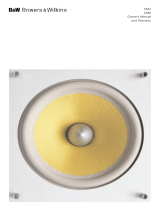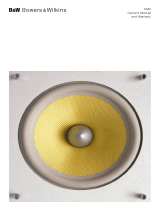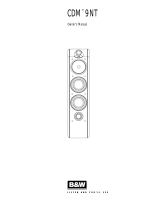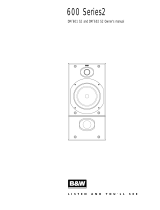Page is loading ...

DM
™
605 S2 Owner’s manual
600 Series2

Figure 1
Figure 2
Figure 4a
Figure 3
Figure 4b
Owner’s manual
DM
™
605S2
>0.5m
>0.5m
>1.5m
≈≈
≈
0.5–1m
>0.5m
>0.5m

Figure 7
Figure 8
Figure 9 Figure 10
F
A
DM
™
605 S2 Owner’s manual
English ...............................1
Français..............................3
Deutsch ..............................5
Español ..............................7
Italiano...............................9
Nederlands .......................11
Dansk
.........................................13

1
SAFETY INSTRUCTIONS
Caution:
To reduce the risk of electric shock, do not
remove the back panel. No user-serviceable
parts inside. Refer servicing to qualified personnel.
Explanation of Graphical Symbols
The lightning flash within an equilateral triangle
is intended to alert you to the presence of unin-
sulated "dangerous voltage" within the product’s
enclosure that may be of sufficient magnitude to
constitute an electric shock to persons.
The exclamation point within an equilateral
triangle is intended to alert you to the presence
of important operating and maintenance
(servicing) instructions in the literature
accompanying the appliance
1 Read Instructions – All the safety and
operating instructions should be read before
the appliance is operated.
2 Retain Instructions – The safety and operating
instructions should be retained for future
reference.
3 Heed Warnings – All warnings on the
appliance and in the operating instructions
should be adhered to.
4 Follow Instructions – All operating and use
instructions should be followed.
5 Water and Moisture – The appliance should
not be used near water – for example, near
a bathtub, washbowl, kitchen sink, laundry
tub, in a wet basement, or near a swimming
pool and the like.
6 Carts and Stands – The appliance should be
used only with a cart or stand that is
recommended by the manufacturer.
7 Wall or Ceiling Mounting – The appliance
should be mounted to a wall or ceiling only
as recommended by the manufacturer.
8 Ventilation – The appliance should be
situated so that its location or position does
not interfere with its proper ventilation. For
example, the appliance should not be
situated on a bed, sofa, rug, or similar
surface that may block the ventilation
openings; or placed in a built-in installation,
such as a bookcase or cabinet, that may
impede the flow of air through the ventilation
openings.
9 Heat – The appliance should be situated
away from heat sources such as radiators,
heat registers, stoves, or other appliances
that produce heat.
10 Power Sources – The appliance should be
connected to a power supply only of the
type described in the operating instructions
or as marked on the appliance.
11 Grounding or Polarisation – The appliance
is double insulated and does not need to be
grounded for safety. However, not grounding
the appliance may increase the level of hum
breakthrough. When using an extension
power-supply cord or a power-supply cord
other than that supplied with the appliance,
it should be fitted with the appropriate
moulded-on plugs and carry safety approval
appropriate to the country of use.
12 Power Cord Protection – Power-supply cords
should be routed so that they are not likely to
be walked on or pinched by items placed
on or against them, paying particular
attention to cords at plugs, convenience
receptacles and the point where they exit
from the appliance.
13 Cleaning – The appliance should be
cleaned only as recommended by the
manufacturer.
14 Non-use Periods – The power cord of the
appliance should be unplugged from
the outlet when left unused for a long
period of time.
15 Object and Liquid Entry – Care should be
taken so that objects do not fall and liquids
are not spilled into the enclosure through
openings.
16 Damage Requiring Service – The appliance
should be serviced by qualified personnel
when:
a The power-supply cord or the plug has
been damaged; or
b Objects have fallen, or liquid has been
spilled into the appliance; or
c The appliance has been exposed to rain; or
d The appliance does not appear to operate
normally, or exhibits a marked change in
performance; or
e The appliance has been dropped, or the
enclosure damaged.
17 Servicing – The user should not attempt to
service the appliance beyond that described
in the operating instructions. All other
servicing should be referred to qualified
service personnel.
WARNINGS
To prevent fire or shock hazard, do not expose
this equipment to rain or moisture.
Observe all warnings on the equipment itself.
To avoid electrical shock, do not open the
enclosure or remove the amplifier from the rear
panel. There are no user serviceable parts
inside. Refer all service questions to an
authorised B&W dealer.
To prevent electric shock, do not use this
(polarised) power plug with an extension cord
receptacle or other outlet unless the blades can
be fully inserted to prevent blade exposure.
Ensure that the voltage indicated on the amplifier
panel matches that of the power supply.
The mains fuse holder is located on the back
panel of the amplifier module. Replacement fuse
must be of the same type and rating as supplied.
An earth (ground) connection is provided in the
mains input socket. However, the equipment is
double insulated and will operate safely without
being earthed (grounded), but may suffer
increased levels of hum breakthrough.
To ensure adequate cooling of the amplifier,
operate the equipment only with the heatsink
fins aligned vertically.
Check that there are no cables under the carpet
that may be damaged by the spikes.
Do not walk the unit on the spikes as this may
cause them to become detached from the
cabinet and cause damage.
Take care not to impale your feet with the spikes.

2
INTRODUCTION
Thank you for choosing B&W.
The DM
™
605 S2 consists of passive midrange
and tweeter sections together with an active
bass section powered by an internal 130 watt
amplifier. This enables the system to function
as a combined full range loudspeaker and
subwoofer, allowing the user to save space in
a home theatre installation by avoiding the
need for a separate subwoofer unit.
Please read this manual fully before unpacking
and installing the product. It will help you to
optimise its performance. As the loudspeaker
is mains powered, you should pay particular
attention to the safety warnings.
B&W maintains a network of dedicated
distributors in over 60 countries who will be able
to help you should you have any problems your
dealer cannot resolve.
UNPACKING
(figure 1)
• Fold the carton flaps right back and invert
the carton and contents.
• Lift the carton clear of the contents.
• Remove the inner packing from the product.
We suggest you retain the packing for future use.
Check in the carton for:
• 4 spike feet with lock nuts.
• Mains power lead
POSITIONING
Do not fit the spike feet until you have found the
best position for your speakers.
Stray magnetic fields
The speaker drive units create stray magnetic
fields that extend beyond the boundaries
of the cabinet. We recommend you keep
magnetically sensitive articles (television and
computer screens, computer discs, audio and
video tapes, swipe cards and the like) at least
0.5m from the speaker.
Stereo Audio
(figure 2)
As an initial guide:
• Position the speakers and the centre of the
listening area approximately at the corners of
an equilateral triangle.
• Keep the speakers at least 1.5m apart to
maintain left-right separation.
• Keep the speaker baffles at least 0.5m clear
of walls.
Home Theatre
(figure 3)
If used for front left and right channels, place the
speakers between 0.5m and 1m from each side
of the screen. If used as surround speakers,
place them to left and right and behind the
listeners. Because the speaker is not magnetically
shielded, it is only suitable for centre channel use
if you are using a projector TV. In that case it
may be placed directly below the centre of the
screen if there is sufficient room.
CONNECTIONS
All connections should be made with the
equipment switched off.
Full range input
(figure 4)
There are 2 pairs of terminals at the back of
the speaker which permit bi-wiring if desired.
On delivery, the separate pairs are connected
together with high-quality links for use with a
single 2-core cable. For single cable connection,
leave the links in place and use either pair of
terminals on the speaker.(figure 4a)
Ensure the positive terminal on the speaker
(marked + and coloured red) is connected to
the positive output terminal of the amplifier and
negative (marked – and coloured black) to
negative. Incorrect connection can result in
poor imaging and loss of bass.
To bi-wire, remove the links by loosening the
terminal caps and use a separate 2-core cable
from the amplifier to each pair of terminals
(figure 4b). This can improve the resolution of
low-level detail. Observe the correct polarity as
before. When bi-wiring, incorrect connection
can also impair the frequency response.
Ask your dealer for advice when choosing
cable. Keep the total impedance below the
maximum recommended in the specification and
use a low-inductance cable to avoid attenuation
of the highest frequencies.
Low-frequency effects (LFE) input
(figure 5)
The LFE or subwoofer output of your decoder is
connected to the LFE input of one of the speakers
using line level coaxial cable terminated by an
RCA Phono plug. Connect the second speaker
LFE input socket to the LFE link out socket of the
first speaker.
Connection to the mains power supply
Ensure that the voltage indicated on the amplifier
panel matches that of the power supply. Should
you need to change the setting, perhaps
because you have moved to an area having a
different supply voltage, slide the voltage
selector switch to the other position WHILE THE
SPEAKER IS DISCONNECTED FROM THE
MAINS POWER SUPPLY.
A 3-core mains power lead appropriate to the
country of sale is supplied that fits the IEC mains
input socket (figure 6A) in the amplifier panel.
The same value mains fuse is used whatever the
supply voltage and it is fitted in a tray at the
bottom of the mains input socket (figure 6B).
REPLACEMENT FUSES MUST ALWAYS BE OF
THE SAME TYPE AND RATING AS ORIGINALLY
SUPPLIED.
The speaker features auto-sensing of the input
signal to switch it between the standby and fully
on modes. This feature only operates if the
AUTO SENSE switch (figure 6C) is set to ON.
On first connecting the speaker and turning the
POWER switch ON, the initial surge is enough
to turn the amplifier fully on and the LED
(figure 7) near the logo at the bottom of the front
panel glows green. If no signal is detected after
a period of approximately 5 minutes, the
amplifier switches automatically to standby and
the LED glows red. In this mode the power
consumption is approximately 4 watts. If a
signal is detected at the input to the speaker,
the amplifier automatically switches fully on
within 0.5 seconds.
FINE TUNING
Before fine tuning, double check that all the
connections in the installation are correct
and secure.
Moving the speakers further from the walls will
reduce the general level of bass. Space behind
the speakers also helps to create an impression
of depth. Conversely, moving the speakers closer
to the walls will increase the level of bass.
If the bass is uneven with frequency it is usually
due to the excitation of resonance modes in the
room. Even small changes in the position of the
speakers or the listeners can have a profound
effect on how these resonances affect the sound.
Try mounting the speakers along a different wall.
Even moving large pieces of furniture can have
an effect.
If the central image is poor, try moving the
speakers closer together or toeing them in so
they point at or just in front of the listeners.
(figure 8)
If the sound is too harsh, increase the amount
of soft furnishing in the room (for example use
heavier curtains), or reduce it if the sound is dull
and lifeless.
Test for flutter echoes by clapping your hands
and listening for rapid repetitions. Reduce them
by the use of irregular shaped surfaces such as
bookshelves and large pieces of furniture.
Ensure the speakers stand firmly on the floor.
Whenever possible fit the spike feet supplied
after you have optimised the positioning. They
are designed to pierce through carpeting to the
floor surface. Initially, screw the lock nuts fully
onto the spikes and screw the spikes fully into
the threaded inserts in the base of the speaker.
If the cabinet rocks, unscrew the appropriate
spikes until the speaker stands firmly on the floor
and lock them in place by tightening the lock
nuts against the base. If you do not have a
carpet, use a protective disc under the spikes to
protect the floor surface.
If you want to raise or lower the bass level
with respect to the midrange and tweeter level,
change the setting of the LEVEL control

3
(figure 6D) on the amplifier panel. The control
is calibrated in dB relative to the ‘0’ position,
which equates to a flat free-field response.
(figure 9)
The equalisation (EQ) control (figure 6E) modifies
the bass cut-off frequency and roll-off rate.
Position ‘F’ corresponds to the maximum output
and gives a 6th-order Butterworth (maximally flat)
anechoic response with a -3dB frequency of
25Hz. However, most rooms give some degree
of boost to the bass frequencies and a better
balance may be found at one of the other
settings. Figure 10 shows how the control affects
the system response. The more gradual the roll-
off rate, the tighter the bass will sound.
Reducing the bass level or extension may allow
the overall speaker to play louder without
distortion, from either speaker overload or
clipping of the amplifier output.
The polarity of the LFE (subwoofer) signal can be
reversed using the PHASE switch (figure 6F) if
necessary. Normally the switch will be set to 0°
(non-inverting). However, some amplifiers invert
the signal between input and output and, if you
are using such an amplifier to feed the full range
part of the speaker, you should set the switch to
180° (inverting), otherwise you will suffer a loss
of bass through cancellation.
For greatest realism in home theatre installations
it is important to balance the speakers and
adjust the acoustic image to match the size of
the screen. With smaller screens it may be more
realistic to have the left and right speakers closer
together than you might for audio alone.
Adjust the levels of the three front speakers to get
a smooth transition of sounds as they pan across
the screen. Adjust the level of the surround
speakers so that, except for special effects, your
attention is not unduly attracted to them.
Sit in all likely listening positions when deciding
on the optimum levels.
Consult your decoder manual for further
information on how to set the levels.
AFTERCARE
The cabinet surface usually only requires dusting.
If you wish to use an aerosol cleaner, remove the
grille first by gently pulling it away from the
cabinet. Spray onto the cleaning cloth, not
directly onto the cabinet. The grille fabric may
be cleaned with a normal clothes brush whilst
the grille is detached from the cabinet.
Avoid touching the drive unit diaphragms,
especially the tweeter, as damage may result.
FRANÇAIS
Avertissements :
Pour éviter tout risque d’incendie ou
d’électrocution, n’exposez jamais cet appareil à
la pluie ou même a l’humidité.
Observez tout signe anormal, n’ouvrez jamais
l’enceinte et ne sortez pas l’amplificateur de son
logement ; vous n’y trouverez aucun réglage utile.
En cas de problème renseignez-vous,
préalablement à toute intervention, auprès
d’un véritable revendeur spécialiste de la
marque B&W.
Pensez que vous risquez l’électrocution si vous
n’enfoncez pas complètement les pôles de
la prise d’alimentation, surtout lorsque
vous employez un prolongateur ou un
raccord électrique.
Assurez-vous, en premier lieu, que la tension
indiquée sur l’appareil correspond bien a celle
de votre réseau électrique.
Les fusibles d’alimentation se trouvent sur le
panneau du module d’amplification. En cas
de remplacement, n’utilisez jamais de fusibles
d’un type différent ; vérifiez que les valeurs
indiquées sur les nouveaux fusibles sont
parfaitement identiques à celles qui figurent sur
les modèles d’origine.
Une borne de mise à la terre est incluse à
l’embase de raccordement au réseau électrique.
Cependant, le matériel est construit avec un
double isolement et peut fonctionner en toute
sécurité sans raccordement à la terre. Le seul
risque peut être une élévation du bruit de fond.
Pour assurer une ventilation suffisante à
l’amplificateur, les ailettes des radiateurs de
refroidissement doivent être orientées en
position verticale.
Contrôlez que les câbles ne risquent pas d’être
transpercés par les pointes de découplage.
Ne déplacez pas l’appareil en le faisant glisser
sur ses pointes. Vous risquez de les arracher ou
de créer des dégats.
Prenez simplement garde de ne pas vous piquer.
INTRODUCTION
Nous vous remercions d’avoir choisi B&W.
La DM
™
605 S2 est la synthèse réussie d’une
enceinte de médium et d’aigu passive et d’un
caisson de grave actif, amplifié par une unité de
puissance intégrée de 130 Watts. Ceci permet
au système de présenter tous les avantages d’un
ensemble à large bande complété par
subwoofer, tout en apportant un gain de place
non négligeable à une installation de type Home
Cinéma, l’emploi d’un caisson de grave séparé
devenant inutile.
Veuillez lire attentivement l’ensemble de ce
document avant de déballer et de raccorder
votre matériel. Il vous aidera à obtenir les
meilleurs résultats. Cette enceinte étant alimentée
par le réseau électrique, vous accorderez une
attention très particulière aux avertissements de
sécurité.
B&W entretient un réseau de distributeurs
officiels dans plus de 60 pays ; ils sont en
mesure de vous aider au cas où vous
rencontreriez des difficultés que votre revendeur
ne pourrait résoudre.
DEBALLAGE
(figure 1)
• Repliez totalement les rabats du carton puis
retournez l’emballage avec son contenu.
• Soulevez le carton pour le vider de
son contenu.
• Retirez l’emballage intérieur.
Nous vous suggérons de conserver l’emballage
pour une utilisation ultérieure.
Vérifiez à ce que le carton contient :
• 4 pointes de découplage avec écrous
de blocage.
• Cordon d’alimentation électrique.
POSITIONNEMENT
Ne fixez pas les pointes avant d’avoir déterminé
la meilleure position de vos enceintes.
Champs magnétiques parasites
Les moteurs de haut-parleurs émettent un champ
magnétique parasite qui rayonne au-delà des
limites de l’enceinte acoustique. Nous vous
recommandons d’éloigner les appareils sensibles
à ce type de rayonnements (téléviseurs et
moniteurs informatiques, disquettes informatiques,
bandes magnétiques audio ou cassettes vidéo,
cartes à puces etc.) à plus de 0,5 m du coffret
de l’enceinte.
Ecoute en stéréophonie
(figure 2)
A titre indicatif :
• Disposez les enceintes acoustiques ainsi
que le centre de la zone d’écoute
approximativement aux trois angles d’un
triangle équilatéral.
• Ecartez vos enceintes d’au moins 1,5 m
pour obtenir une séparation gauche/droite
suffisante.
• N’approchez jamais vos enceintes à moins
de 0,5 m d’un mur.
Home Cinéma
(figure 3)
En utilisation comme enceintes avant gauche et
droite, placez les entre 0,5 et 1 mètre des bords
de l’écran. Utilisées comme enceintes
d’ambiance, elles seront disposées à gauche et à
droite et en arrière de la position d’écoute. Les
haut-parleurs n’étant pas blindés, vous ne pourrez
les employer comme voie centrale qu’avec un
projecteur vidéo. Dans ce cas, l’enceinte sera
installée directement derrière le centre de l’écran,
pourvu qu’il soit acoustiquement transparent et
que vous disposiez de la place nécessaire.

DM
™
605 S2
Kevlar is a registered trademark of DuPont.
B&W Loudspeakers Ltd reserves the right to amend details of the specification without notice in line with technical developments.
Copyright © B&W Loudspeakers Ltd. Printed in England.
B&W Loudspeakers Ltd, Meadow Road, Worthing, BN11 2RX, England. Tel: +44 (0) 1903 524801 Fax: +44 (0) 1903 524725
http://www.bwspeakers.com
II 08370 Issue 2
Description
Drive units
Frequency range
Frequency response
Dispersion
Sensitivity
Harmonic distortion
Nominal impedance
Crossover frequencies
Passive power handling
Max. recommended
speaker cable impedance
Amplifier
Dimensions
Net weight
3-way vented-box system with active bass
2x 180mm (7in) paper/Kevlar
®
cone bass
1x 180mm (7in) woven Kevlar
®
cone midrange
1x 26mm (1in) metal cone high-frequency
-6dB at 23Hz (adjustable) and 30kHz
25Hz (adjustable) – 20kHz ±3dB on reference axis
Within 2dB of response on reference axis
Horizontal: over 40° arc
Vertical: over 10° arc
91dB spl (2.83V, 1m)
2nd & 3rd harmonics
<1% 42Hz – 20kHz (90dB spl, 1m)
8Ω (minimum 3Ω)
230Hz, 4kHz
25W-200W continuous into 8Ω on unclipped programme
0.1Ω
Power output: 130W continuous
Input impedance: 100kΩ
Signal/noise: 91dB
Functions: Bass level
Bass equalisation
LFE phase 0°/180°
Auto-sensing standby/on
Inputs: Speaker level (binding posts)
LFE (RCA Phono)
Outputs: LFE link to 2nd unit (RCA Phono)
Height: 996mm (39.2 in)
Width: 236mm (9.3 in)
Depth: 440mm (17.3 in)
31kg (68.2 lb)
/









